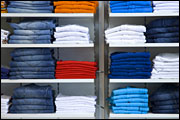
A few weeks ago, a good friend of mine invited me to an apparel industry environmental seminar chock full of good industry types. Seminars of this nature are always dreadfully boring, but it’s worth it because you get the inside scoop on what the industry is (and unfortunately isn’t) talking about. The principle topic was regulated substances and chemicals, how to move toward green chemistry alternatives, and how to manage all the issues associated with regulations. The meeting was the first important step in getting companies like Ann Taylor, Liz Claiborne, L.L. Bean, and others to begin taking the steps needed to beef up their consumer-protection standards.
The buzzword of the day was RSL, or “Restricted Substance List.” Most RSL’s are either proprietary information or outdated. That is all changing thanks to the American Apparel & Footwear Association‘s Environmental Task Force, which spearheaded the seminar.
On June 27, AAFA released an RSL to help textile, apparel, and footwear companies take the first step in regulating — and, in some cases, eliminating — certain contaminants from their products. I emphasize “first step” because many of the companies sitting in the auditorium were only marginally aware that so many chemicals and substances made up the DNA of their outfits.
AAFA’s RSL, though robust, is not a “best practices” list. It only includes chemicals that are restricted or banned in finished goods because of a regulation or law. For each restricted substance — including chromium, the flame retardant DecaBDE, hydrofluorocarbons, dioxins, PERC, disperse dyes, azo dyes, and pesticides — the most restrictive regulation is noted. In most cases, it is the European Union that has the strictest regulation.
The accredited task force and peer review group behind the list, which includes companies such as Levi Strauss, Bureau Veritas, Nike, Hanesbrands, Oeko-Tex, American Chemistry Council, DyStar, and a host of others, will update the list every six months to ensure that it is kept current.
According to some of the members of the task force, there will eventually be a best practices list released, but not anytime this year. On the most exciting front, Andy Chen, director for RSL and Asia Communications of Nike, shared that the company will soon be disclosing its expanded list of regulated and banned substances in addition to the cleaner, greener substitutes. “Nike has a green chemistry program in development,” said Chen. “RSL is really only the first step. We’re releasing this information because we want to increase the use of green chemistry options.”
The release of proprietary lists for Nike may be more financial than altruistic, since purchasing more “green” chemistry alternatives will help drive down the cost. What seems more altruistic than financial for Nike, however, is their openness in discussing their “lessons learned.” This included TBT traces in a jersey (a chemical unknown to Nike at the time), cadmium in soccer balls, and lead paint on baby shoes. As soon as the chemicals were detected in routine testing, the products were incinerated, but the cost associated with bad public perception and supply chain management totaled approximately $12.75 million.
With a few exceptions, like Nike and Levi’s, restricted substances will continue to be a challenge for most apparel retailers and manufacturers. Most manufacturers do not own their own factories, so it is difficult to regulate what is going on behind closed doors. And many retailers and manufacturers are just starting to consider developing an RSL, so no solid teams are in place to take on the job as of yet. Lastly, issues like private labeling, differing international regulations, and varying state regulations (e.g., California’s “right-to-know” Prop 65 law) complicate the matter.
I wouldn’t be surprised to see all the companies in the audience within the next three to five years coming out with their own RSLs — and plans on how to extend “consumer-protection” standards to “worker-protection” standards.



